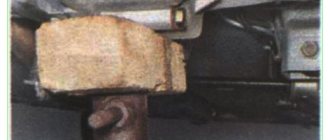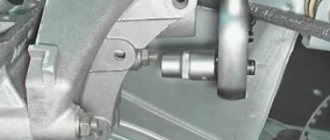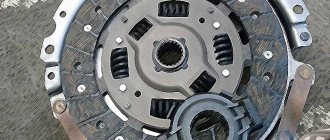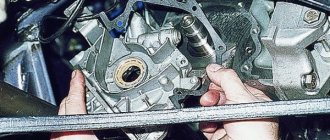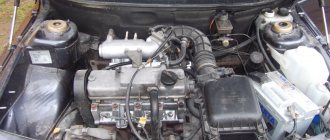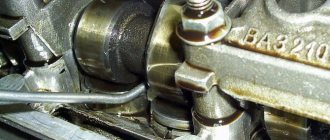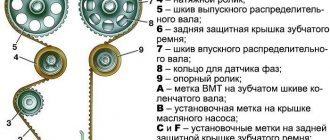Hatchbacks of the 2112 family were produced with different 16-valve engines - 21124 and 21120. Before removing the valve cover, on the VAZ-2112 you will need to disassemble the intake module mount, as well as remove all the brackets attached to the top of the cover. The high-voltage wires are also disconnected, and the ignition module is removed from the 21120 engine. Let's look at all the steps in more detail.
The following video shows what the part that needs to be removed looks like.
Necessary parts and tools for repair
Troubleshooting the cylinder head begins with the purchase of original parts and various consumables, the list of which is as follows:
- Fuel intake system valve 8 pcs. (art. 21120-1007010).
- Exhaust gas valve 8 pcs. (art. 21120-1007012).
- Set of hydraulic compensators 16 pcs. (art. 21120-1007300).
- Gaskets for valve cover, cylinder head, intake manifold, exhaust manifold (all come as a set art. 21120-1002064-86).
- Bolts securing the cylinder head to the engine crankcase (art. 21120-1003271-018).
- Timing belt (art. 2112-1006040-02RU), timing tension roller (art. KT100507/100513), drive belt for mounted units (art. BP638).
- Engine oil and oil filter.
- Cooling system fluid.
Installation of valves on a VAZ 2112 is carried out using a standard set of tools, as well as several specialized types of keys:
- standard set of spanners from 8 to 24 mm;
- socket sockets in a set from 8 to 27 mm;
- end internal hexagons;
- mechanical valve retaining ring remover (depressurizer);
- torque wrench for tightening the cylinder head and camshaft bolts;
- paste for grinding valves (set for rough and fine grinding);
- metalworking cloth gloves to protect hands while working.
The work of replacing 16 valves on a VAZ 2112, the price of which as of this fall is about 50 thousand rubles at AvtoVAZ dealerships (or approximately 35-40 thousand rubles at ordinary car repair shops), is not a very complicated process. You can carry out the work yourself, for which it is enough to purchase the above-described spare parts and the necessary tools.
Preparing for work
The valve cover gasket can be replaced in any convenient place - in an open area or in a garage. There is no need to drain engine lubricant or antifreeze. What tools will be needed for disassembly:
- a head with an extension and a knob, suitable in size to the cover mounting bolts;
- flathead and Phillips head screwdrivers;
- pliers;
- rags.
Work is carried out with the power unit cooled down to a comfortable temperature. If you don’t have time to wait for the engine to cool down, perform disassembly wearing cloth gloves that protect your hands from burns.
Before replacing, prepare the following consumables:
- a new gasket element selected according to the car model;
- O-rings for bolts (installed on certain brands of cars);
- high temperature sealant and degreaser such as white spirit.
The use of sealants to treat the seal before installation is not necessary. For example, on engines of classic VAZ 2101–07 models, the gasket does not require additional sealing. On 16-valve engines with a wider flange, the use of sealant is desirable, but not required.
Advice. Take your time to buy and change a gasket that leaks a little oil at one point. First, check and tighten the threaded connections - perhaps the seal has sagged and the bolts have become loose. If the operation does not help and drips still appear, the gasket element will have to be replaced with a new one.
Dismantling
It begins with the removal of all cylinder head attachments (intake and exhaust manifolds, radiator pipes, air filter duct, high-voltage wires and spark plugs), timing belt protective cover, resulting in access to the valve cover fasteners. We unscrew the tension roller of the generator and timing belts, remove them, then proceed to dismantle the valve cover fastenings, unscrew them, gaining free access to the cylinder head bolts. We unscrew them, after which the cylinder head can be removed from the engine crankcase.
Watch the video
The valve cover is a part that often has to be removed, especially if we are talking about a car from the domestic auto industry. So, for example, if we talk about the VAZ-2106, the valve cover is removed when adjusting the valves, and when checking the timing belt tension, and when dismantling the engine, and when replacing gaskets, and for many other tasks.
Of course, everyone should be able to perform this procedure independently. Fortunately, it’s quite simple to do and takes about half an hour, so it’s not even advisable to go to the salon to have it done. Let's figure out how to remove the valve cover to replace this or that part, using the VAZ-2106 as an example.
Repair
The cylinder head removed from the engine and placed on a workbench is disassembled. The fasteners of the camshafts are unscrewed and they are carefully removed, then the hydraulic compensators are removed from their seats and, using a screw depressurizer, the valve retaining rings (crackers) are dismantled, after which they are pulled out from their workplaces. After disassembling the cylinder head, we thoroughly clean it of technical contaminants. Each new valve must be ground into its working surfaces; this is done using a drill and a special grinding paste.
Having finished sanding, the working surface is thoroughly wiped with a cloth. All new parts are installed on the cylinder head. The timing mechanism (valve lifters, hydraulic compensators, camshafts and their front seals) is reassembled and the cylinder head is ready for installation on the engine.
Which one to choose
There are a lot of products on sale from different manufacturers. There are original components and replacements. Original cuffs are a priori better. They provide tightness longer, but cost several times more.
On the other hand, the quality of some analogues can also be excellent. A lot depends on the brand. For example, the Viktor Reinz brand is a worthy analogue. Reinz gaskets are equipped with special thickenings (or protrusions) so that when tightening, not the entire surface of the seal is pressed in, but only the profile. This ensures the reliability of the product; the rubber can withstand temperature changes longer.
Analogue products from Viktor Reinz are very popular. They are installed on Lacetti, Duster, Almera. They cost less than the originals but last longer.
Installation
They start by cleaning the surface of the engine crankcase from gasket remnants and traces of leaks of technical fluids, then a new cylinder head gasket is installed in the seat and the assembled head is carefully put on special guides, after which, according to a special scheme, its mounting bolts are tightened with a torque wrench to the required forces.
The next step is to install the timing belts and generator, screw all the attachments into place, pour new oil and antifreeze into the engine, start the engine and carefully monitor it for fluid leaks and extraneous noise. Also watch the video of replacing valves on a VAZ 2112 (16-valve):
Hatchbacks of the 2112 family were produced with different 16-valve engines - 21124 and 21120. Before removing the valve cover, on the VAZ-2112 you will need to disassemble the intake module mount, as well as remove all the brackets attached to the top of the cover. The high-voltage wires are also disconnected, and the ignition module is removed from the 21120 engine. Let's look at all the steps in more detail.
The following video shows what the part that needs to be removed looks like.
What is she?
This spare part can be seen immediately after you open the hood. The purpose of this element is to seal the neck of the gas distribution mechanism (so that oil does not penetrate into unnecessary places). The cover itself is secured with several bolts or nuts. And the VAZ valve cover gasket is made from special rubber, which does not lose its properties even with prolonged heating. However, nothing in the world is eternal, and even such material loses its elastic properties over time.
Removing the valve covers on engine 21120 (16v 1.5)
None Removing the box with the air filter To remove the filter, loosen clamps 1 and 2, and then disconnect connector 3. Pipes 1 and 2 are removed from the box. Use a 10mm wrench to unscrew the screw on the body, then remove the box from its mountings.
With a plastic cover, everything looks simple: either it is screwed on with bolts (key “10”), or held on with rubber bands. In the first case, the bolts are unscrewed, in the second, the cover is pulled up. The main thing is to unscrew the filler plug.
To disconnect high-voltage cables, you need to pull the caps out of the wells. The cables are also disconnected from the ignition module. It is pressed to the valve cover with three 10mm nuts.
We've sorted out the ignition module. Don't forget to disconnect the low-voltage connector and dismantle the module. If you do not unscrew the module, you will not be able to remove the valve cover on a VAZ-2112.
What you need to know about a torque wrench
The bolts are tightened in a certain sequence - from the center to the edges, one at a time. If you are not a motor mechanic with extensive experience and an experienced hand, then the main condition for the correct performance of the work will be the use of a torque wrench. This tool is widespread everywhere, it is easy to buy or rent - just look at the newspaper advertisements or go to your neighbor’s garage.
Torque wrenches come in different designs, but they are all designed to measure the tightening force of threaded connections. When choosing a key, you need to find out in what units the measurement is taken and whether it matches the car manufacturer’s instructions.
In the international SI measurement system, the tightening force is called newton meters, in Russia it is often called kilogram meters, for some foreign cars you can find measurements in pound-force feet. To avoid errors when converting one unit of measurement to another, you can purchase a key with different scales.
Table: how to convert measurements from newton meters to pound-force feet
| Newton meter | 10 | 50 | 100 | 250 | 500 | 1 000 | 2 500 | 5 000 |
| Pound-force-foot | 7.376 | 36.878 | 73.756 | 184.391 | 368.781 | 737.562 | 1 843.906 | 3 687.811 |
To make sure your actions are correct, you can use a protractor to monitor the angle of rotation of the bolt after tightening it with a torque wrench.
This is what a torque wrench looks like, allowing you to correctly determine the force for tightening threaded connections
The part called “receiver”
First of all, you need to remove the throttle assembly: unscrew the cap on the antifreeze tank, disconnect the TPS and IAC connectors, unscrew the two fastening nuts (wrench “13”). It is also advisable to disconnect the negative terminal from the battery.
What to do before removing the receiver: Using a “10” wrench, unscrew the cable mounting bracket from the receiver. All that remains is to remove the throttle assembly: the operation is carried out so that the assembly remains above the expansion tank. The assembly itself is finally attached to the body partition.
On motor 21120 we remove the receiver, that is, the upper part of the intake module:
- The ignition wires come out of brackets 1 and 2.
Then, loosening the clamp, you need to disconnect the brake system hose. What needs to be disconnected from the receiver. - From the studs on the 1st and 4th tubes, remove the clamps holding the wiring harness.
- Using an “8” wrench, loosen the nuts on the four clamps. Using a “10” wrench, the two fastening nuts are unscrewed, and the receiver can be removed.
The crankcase ventilation hose is disconnected from the cylinder head cover. The final touch before dismantling In the photo, the intake manifold holes are closed with plugs. The filler plug is screwed in.
Selecting a cylinder head gasket
Today you can find several types of cushioning products on sale:
- Asbestos gaskets. The main advantage of these seals is minimal shrinkage and good recoverability during operation.
- Metal. This type of product is one of the most reliable and high-quality, they have a long service life and are not so susceptible to damage as a result of overheating of the internal combustion engine.
- Non-asbestos. Typically used as repair kits. The main advantages of such gaskets are elasticity, heat resistance and elasticity.
The article number of the original product for the twelfth VAZ model is 2112-1003020. For the same brand of vehicles, high-quality gaskets are produced by the manufacturer Ajusa, product catalog number - 10144200.
User Sergei Tsapyuk published a video demonstrating the consequences of a damaged cylinder head gasket.
How to remove a plastic intake module
A wiring harness is attached to the front of the intake module. The cables go to the DPKV, DPRV (DF) sensors and to the adsorber valve. All connectors must be disconnected, then the wiring harness is removed.
The photo shows how the brake system hose is disconnected, as well as the crankcase ventilation hose. It is also necessary to remove the oil dipstick and tube by unscrewing screw 1.
Plastic part attachment points:
- Key “10” : two nuts 1;
- Key “13” : three nuts 2, two bolts 3.
All elements are shown in the photo.
Pad
Replacing the valve cover gasket on a VAZ 2110
In fact, the valve cover gasket is a minor element; it does not affect the performance of the engine or other technical parameters. But if this gasket starts to leak, you need to prepare for some trouble. The main sign of taking care of your car is a clean and dry engine, which is also reflected in the condition of various gaskets, seals and seals.
Note! A good valve cover gasket is the key to a clean and well-maintained engine.
Replacing the 8th valve cover gasket of a VAZ 2110
The valve cover immediately catches your eye when you open the hood of the car. Most car enthusiasts paint this accessory and the air cleaner body in bright colors. So:
- The cover is designed to cover the gas distribution mechanism; it has a neck for changing engine oil. This neck is attached to the cover itself using several bolts. There must be a special gasket between these parts.
Note! The gasket is made of a special composition, the basis of which is rubber. In this case, all properties are preserved when exposed to high or low temperatures. In addition, the composition does not interact with engine oil.
Sooner or later, the gasket loses its elasticity and becomes hard. Later, microcracks form through which oil leaks. Even due to minimal leaks, the engine quickly becomes covered with dirt, which is difficult to wash off.
When and why is replacement needed?
Valves on different parts of the car wear out at different rates. Of course, cylinder head devices will last significantly less than their stove-mounted counterparts. Timely installation of new valves allows you to avoid losses in engine power, stabilize its operation, and improve dynamic performance, which will significantly deteriorate with wear.
If the valves fail, an experienced car enthusiast will immediately notice changes in the behavior of the car. First of all, this is a characteristic knocking sound in the engine, caused by an increase in the gap between the camshaft and the crankshaft cams. The causes of malfunctions may be as follows.
- Timing belt break.
- Unscrewing the crankshaft mounting bolt.
- The valves come out of their seats, which will become noticeable immediately after you remove the cylinder head cover.
- Wear and thinning of device legs, which is determined using a special measuring tool.
- Depressurization of the structure, appearance of dents, cracks, and chips on it.
It is recommended to check valves not only after detecting characteristic signs of damage. AvtoVAZ advises installing new units after a certain mileage. If your Lada 2112 is already approaching the limit value for this indicator, then it’s time to look under the cylinder head cover and see what condition the valves are in. Next, we’ll talk about how to dismantle devices to assess their performance and possible replacement.
Adjustment of valves
If knocking, unstable operation, or increased vibration occur, you should pay attention to the valves.
If the valve timing of the gas distribution mechanism is disrupted, they do not operate accurately, that is, the full volume of gas does not enter the working area of the cylinders, complete combustion of the fuel-air mixture in the working chamber does not occur, and the cylinders are not purged. This is all accompanied by the appearance of a shock load on the camshaft cams on the drive lever and the shaft rod. Fuel and engine oil consumption also increases. What happens if you drive with unadjusted valves? Answer: rapid wear of engine parts, increasing cost and repair time.
